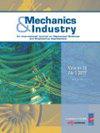Optimal design to control rotor shaft vibrations and thermal management on a supercritical CO2 microturbine
IF 1.2
4区 工程技术
Q3 ENGINEERING, MECHANICAL
引用次数: 3
Abstract
Supercritical carbon dioxide (SCO2) Brayton cycle microturbine can be used for the next generation of solar power. In order to comprehensively optimize the supporting system and cooling device parameters of Brayton cycle shafting, the concept of chaos interval is introduced by chaotic mapping, and the CIMPSO algorithm is proposed to optimize the multi-objective rotor system model with nonlinear variables.The results show that the resonance amplitude of the optimized model is effectively attenuated, and the critical speed point is far away from the working speed, which shows the robustness of the optimization algorithm. Finally, based on arbitrary several sets of optimization solutions and empirical parameters, the finite element model of shafting is established for simulation, and the results show that the optimized solution has certain guiding significance for the design of the rotor system.The cooling device is designed and simulated by CFD method based on the optimal solution set. Both the inlet boundary conditions of given pressure (1 MPα) and given mass flow rate (0.1 kg/s) numerical calculations were carried out to characterize the cooling performance, for different jet impingement configurations (Hr/din = 0.0125 ∼ 5).Several sets of analyses show the strong effects of the jet-to-target spacing (Hr/din) on the rotor thermal performance at a given diameter (din) of the nozzle. Average temperature (Tc) at the free end of the rotor show that, as jet-to-target distance decreases (0.0125 ≤ Hr/din ≤ 0.33), the heat dissipation efficiency of the cooling device with the given pressure boundary condition tends to decrease, while the conclusion is opposite when the inlet boundary condition is set to the given mass flow rate. And there is an interval for the optimal combination (Hr/din) to promote the cooling efficiency.超临界CO2微涡轮转子轴振动控制与热管理优化设计
超临界二氧化碳(SCO2)布雷顿循环微型涡轮机可用于下一代太阳能发电。为了对布雷顿循环轴的支承系统和冷却装置参数进行综合优化,通过混沌映射引入混沌区间的概念,提出了CIMPSO算法对含非线性变量的多目标转子系统模型进行优化。结果表明,优化模型的共振幅值得到有效衰减,临界转速点远离工作转速,显示了优化算法的鲁棒性。最后,基于任意几组优化解和经验参数,建立了轴系有限元模型进行仿真,结果表明,优化解对转子系统的设计具有一定的指导意义。基于最优解集,采用CFD方法对冷却装置进行了设计和仿真。在给定压力(1 MPα)和给定质量流量(0.1 kg/s)的进口边界条件下,对不同射流冲击配置(Hr/din = 0.0125 ~ 5)的冷却性能进行了数值计算。几组分析表明,在给定喷嘴直径(din)下,射流与目标间距(Hr/din)对转子热性能有很强的影响。转子自由端平均温度(Tc)表明,在给定压力边界条件下,随着射流到目标距离的减小(0.0125≤Hr/din≤0.33),冷却装置的散热效率有降低的趋势,而在给定质量流量的进口边界条件下,则相反。为了提高冷却效率,最佳组合(Hr/din)存在一个区间。
本文章由计算机程序翻译,如有差异,请以英文原文为准。
求助全文
约1分钟内获得全文
求助全文
来源期刊

Mechanics & Industry
ENGINEERING, MECHANICAL-MECHANICS
CiteScore
2.80
自引率
0.00%
发文量
25
审稿时长
>12 weeks
期刊介绍:
An International Journal on Mechanical Sciences and Engineering Applications
With papers from industry, Research and Development departments and academic institutions, this journal acts as an interface between research and industry, coordinating and disseminating scientific and technical mechanical research in relation to industrial activities.
Targeted readers are technicians, engineers, executives, researchers, and teachers who are working in industrial companies as managers or in Research and Development departments, technical centres, laboratories, universities, technical and engineering schools. The journal is an AFM (Association Française de Mécanique) publication.
 求助内容:
求助内容: 应助结果提醒方式:
应助结果提醒方式:


